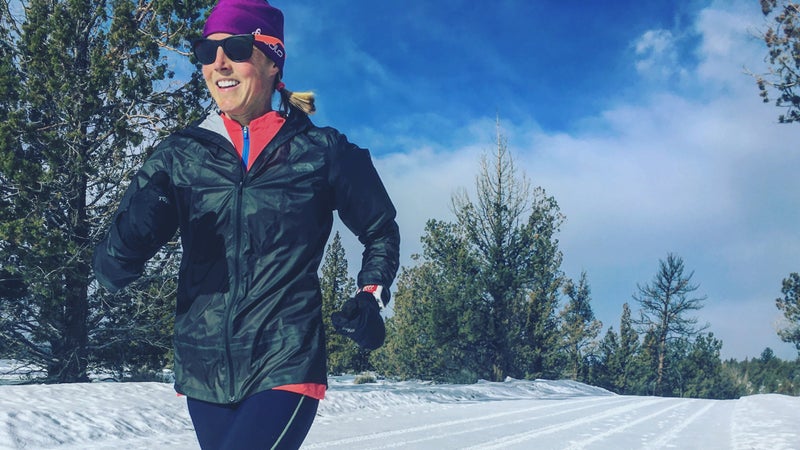Every athlete knows that comebacks aren’t easy. (Just ask Lindsey Vonn.) Regardless of whether you’re returning from an injury or a voluntary hiatus, regaining your previous form can pose a challenge that’s as much mental as it is physical. Your body may be slow to relearn movements that once came with fluid ease, just as your mind wonders why the hell it’s taking so long.
The process can be particularly daunting for runners. In an age when we have an oppressive abundance of activity trackers and GPS devices, there’s no place to hide when your fitness isn’t up to snuff. Your Garmin becomes a brutal reminder of how much faster you used to be.
At some point, however, all runners have to grapple with the challenge of regaining their lost form. (Unless you’re this guy.) To prove that even the most formidable practitioners of the sport are not immune to the trials of the comeback trail, we asked four top-level runners to reflect on the experience of starting up again. While their approaches differed, a common theme emerged: even for the most accomplished of elites, what mattered most was simply being able to run again.
We hear that.
Lauren Fleshman

When she was pregnant in 2013, two-time 5,000-meter national champion Lauren Fleshman technically took only 12 weeks off from running. But as far as serious training goes, she says a good year was compromised, as she didn’t have the smoothest of pregnancies. For Fleshman, coming back meant “starting from scratch” and contending with an eerie sense of not having total control of her own body.
“I feel like there’s a point of no return when you finally have to let go of any fitness you previously had and just accept that you’re going to be starting over. When your break [from running] exceeds that point of no return, it’s actually kind of pleasurable to come back because your expectations are that you’re starting from zero. For me, I just missed the feeling of running. [When I start running again], even though I felt like I was breathing like a freight train and everything hurt, somehow it didn’t bother me. The joy of moving and getting started overwhelms the negativity. But it definitely helped me to understand what it feels like for people who are just getting started [as runners]. The first minute or two was bliss. Like I was free to finally do it. But then the reality of the challenge set in. My legs were thundering. My body was jiggling. I felt floppy through my core. I wasn’t this fined-tuned efficiency machine anymore. I just felt a little bit out of control of my body, and that was disorienting. So, first it was emotional, and then it was just a body-awareness thing, how I was just moving differently through space.”
Postscript: Fleshman retired from professional running in 2016. She now runs the energy bar company Picky Bars. She still runs every day.
Michael Wardian

Michael Wardian, perhaps the world’s most prolific semipro marathoner, had to take four months off in 2012 when he came down with five pelvic stress fractures and five hernias. Though he was able to stay reasonably fit by biking and aqua-jogging, it was the most substantial “break” he had ever taken since he started running seriously. Wardian vividly recalls his first longer run outside after the injury—an eight-mile route from the U.S. Marine Corps War Memorial in Arlington—and the way it spurred a simultaneous sense of gratitude and relief.
When I was injured, I had every emotion—from thinking my career was over to that I’d never be able to run again. I was put back together with mesh after my hernia surgery, and I was really worried that I was going to tear the mesh or that I was going to tear my muscle. And I was nervous about how I would deal with it mentally if I wasn’t the same runner and athlete I used to be—going from being one of the top athletes in the world to being someone who just finishes. And at that point, I was content to just be someone that finishes. I love winning, and I love being competitive and challenging myself, but I love running more than that. [For my first run back] I called my friends, and we did an eight-mile loop. Even though I still had good fitness from the aqua-jogging and the cycling, I remember being so nervous about the run. My legs were fatigued like crazy from just taking impact—it felt like I ran 20 miles—but I remember finishing the run and being absolutely ecstatic when I didn’t have any pain. I just remember feeling so grateful. I keep that feeling of gratitude to this day.
Postscript: In January of this year, Wardian ran seven marathons on seven continents in seven days. His average race time was 2:45:56.
Stephanie Howe

In December 2015, following a long period of nagging pain, elite ultrarunner Stephanie Howe underwent Achilles surgery on her left foot. Howe, whose accolades include winning the 2014 Western States Endurance Run, says her recovery was hampered by an ill-fated attempt to be ready in time for last summer’s Western States. A stress fracture in Howe’s hip (from biking!) served as a wake-up call that you shouldn’t rush the recovery process.
When all is said and done, I spent over a year away from the sport I love. [Before surgery] my days revolved around running or rehabbing from running—taking care of my body with yoga or bodywork stuff. The summer before I had surgery, I did the Western States 100 and UTMB, which is also a 100-mile race, so I was racing at a high level and really trying to train and perform.
[After surgery] I really wanted to run Western States again in June 2016. So I cross-trained really hard through the winter. When I got the okay to start running, I had overdone it and ended up injured again. I learned a huge lesson that when you’re injured, you should let everything go and just heal. So I didn’t put anything on the calendar. No races. Every athlete is different, but [when coming back from injury] I think it’s important to not have a race on the schedule, because otherwise you force yourself to push limits too quickly, rather than doing it when you’re ready. I think it’s helpful to not have any expectations and be totally honest with yourself about how your body is doing, because it’s easy to talk yourself into thinking you’ve progressed further than you really have.
After I blew it that summer, I let go of trying to cross-train. I just reframed my thoughts. I’ve always been an athlete, but I try to stay well-rounded and keep other things going on, just in case something like that happens. It was good, because I actually had a great summer despite not running a step or really cross-training. I just kind of enjoyed life. I cross-trained a little bit, but it was more like, “Oh, I’m going to go for a swim today because it’s sunny and I want to get a tan.” Or “I’m going to go camping with my dog and go for a bit of a hike.” I didn’t force that stuff, and because I wasn’t thinking about how I had to get myself back into shape, it just happened—and it was so much easier. In September, when it came time to start trying to run again, I felt good and was able to slowly progress because I had no expectations. By that point, I was kind of like, “If I can’t race again, that’s okay. I just want to be able to run again. I miss this so much.”
Postscript: In January, Howe won the Bandera 100K, thus ensuring entry into this summer’s Western States. She was the overall race winner. “I beat all the boys,” she says.
Kara Goucher

When you’re a pro athlete, “time off” from running carries a different meaning than it does for the lumbering masses. Kara Goucher, the 2007 10,000-meter World Championships silver medalist, for instance, ran throughout her 2010 pregnancy but, in her own assessment, “didn’t do anything hard.” Goucher had committed to racing the Boston Marathon six months after giving birth and found that the most difficult readjustment was willing herself to cross the pain threshold.
My son was born at the end of September. I was back at practice within a month of having him because I had made the commitment [to race Boston], but it still took a while before I felt comfortable to push myself. I was just so scared, and there was just this barrier. Because when you’re pregnant, the whole time, it’s like, “Just don’t breath too hard!” and “Don’t get your heart-rate up too high!” You kind of accept just being a turtle, and you kind of enjoy it. But when you’re an elite athlete, you can’t do that—you have to be willing to ride that discomfort line, so that was really hard for me to get back into.
I remember the day where my coach got mad at me. We were doing 200s on the track, and he said, “Just run all out. On this one, I don’t want you to look at a watch. I want it to hurt. I want it to be scary. There’s going to come a point where you have to make a decision. Are you going to come back or not? I just want you to run all out.” And I did. My body didn’t fall apart. I breathed really hard, but my breathing came back into control quickly. I started to feel tired halfway through that 200, but I was able to keep going. It was the day where I finally decided, “Okay I’m going to hurt.” And I survived it. And then the next time I went out to do a harder session, I was a little bit more brave, a little bit more willing to risk, and it all started coming back together. It just turned things around for me and helped me remember that it’s okay to run hard.
Postscript: In April 2011, Goucher finished fifth in the Boston Marathon and ran 2:24:52. It remains her career PR.

